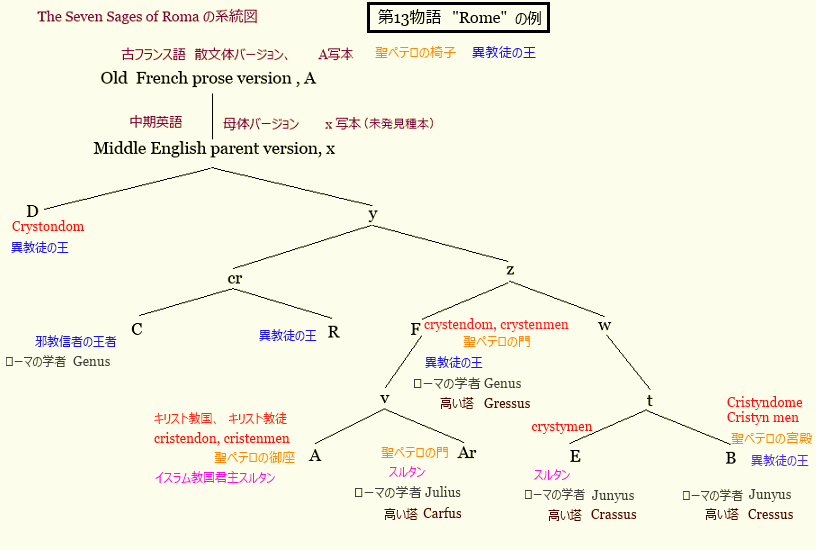44ページ
E版とB版は、あるいは共通種本(仮定t)からの派生かも知れない有力な論拠があります。その例は
第13物語"Rome" E,B 2779行です。
[原文参照翻訳者(現代英語)
E版:A morowe come thys Junyus 朝が来るとこのジュニアスは、
( A morrow come this Junyus)
B版:The morrow came and this Junyus 翌日になりそしてジュニアスは、
(The morrow came and this Junyus)
E版:And stode a toure that het Crassus そしてクラッススと呼ばれる塔に立ちました。
(And stood a tower that hight Crassus)
B版:Stode in a towr that hight Cressus クレッススと呼ばれる塔の中に立ちました。
( Stood in a tower that hight Cressus)
Ar版: On morowe come þis Julius 朝にこのジュリアスは来ました。
( On morrow come this Julius)
F版: On þe morowe þys man þat hyght Genus 翌日にジェーナスと呼ばれたこの男は
( On the morrow this man that hight Genus
Ar版:Into þe tour þat hiӡt Carfus カーフスと呼ばれる塔の中に入りました。
( Into the tower that hight Carfus)
F版:Wente to a towre that hyght Gressus グレッススと呼ばれる塔に上りました。
( Went to a tower that hight Gressus )
『C版は金子健二氏訳のローマ七賢物語』参照
C版:Ane of þa clerks hight Genus; 『これらの学者の一人にジェーナスと呼ぶ名がありました、』
He was ful quaynt(wise) and cautelus(crafy); 『彼は非常な賢者でありました上に計略に富んだ人物でありました。』
And efter him as named Ienuere, 『それがために彼の名にちなんでジェ二ューアという名が生まれました。』
Þat es a moneth of þe ӡere. 『これは一年の中の一つの月の名前であります。』
19行後、
On þe morn, with sheld and spere. 『明朝、楯と槍を携えて…。』
Þe maiter þan dyd on his gere. 『この学者はその時彼の衣を身につけました。』
And went vp in a towre on hight, 『そして高い塔の上に上りました。』
hight について;現代英語辞書にもある形容詞hight≪古・詩≫...と呼ばれた、名付けられた、
(called,named):
E,B,Ar,F版 では塔に名前がありC版では塔に名前はなく現代英語high 高い塔
学者名について、
共通スペル
C & F版:Genus,
E & B版:Junyus,
Ar版:Julius 、(紀元前100-紀元前44年、ローマ共和制末期の政治家、軍人のガイウス・ユリウス・カエサル:Gaius Iulius Caesar、
英語読みジュリアス・シーザー:Julius Caesarを彷彿させる綴りである。)
塔名について、
共通スペル
E版:Crassus B版:Cressus F版:Gressus Ar版: Carfus
(紀元前115頃ー紀元前53年、共和制ローマ時代の政治家、軍人のマルクス・リキ二ウス・クラッスス:ラテン語
Marcus Licinius Crassusと思しき綴りである。Ar版はそれらとは無関係なspellingであるが同系統A版は不明。)
January 一月の語源は、 『month of Janus 頭の前後に顔を持った古代ローマの神ヤヌスの祭りの月の意、
ME(中期英語):janivere, genever, フランス語:janvier, イタリア語:gennaio, スペイン語:enero
研究社、英語語源小事典より。 門や戸口を守護する神、旧年と新年の両方を見ることからJanuaryの語源となる、旺文社
コアレックス英和辞典。』
第13物語「ローマ」では、古代ローマの神の面をつけた賢人ジュリアスのトリック戦闘シーン
を見てサラセン人達はキリスト教の神の出現と恐れて退軍しました。
]
Introduction 本文の続きから:
Genusでなく
E,B両版のローマの学者名:Junyusは間違っていますが、彼にちなんで名づけられた月がJanuaryであることを維持しています。
E版とB版は系統図の共通種本tから分岐した仮説が成立するのは共通エラーだけでなく、A版とAr版そしてC版とR版か古フラン語版か
どれにでも保たれている幾つかの対句の共通加筆、あるいは共通脱落にも基づくからです。
それにもかかわらずキャンベル氏とブルンナー氏の分類に不利なものとして引証できる共通異文の例が他にもあります。
"Rome"において、B版はローマ包囲軍をhethen kynges heathen kings
異教徒の王とみなして
それはC,R,F版とD版に一致していますが、E版は、攻囲軍をsultansイスラム教国君主スルタン(サルタン)と呼び
A, Ar版と一致しているのです。
この例は、
原文比較(翻訳者調べ)
B版:With vij hret hethen kynges 7人の異教徒の王のせいで
(With seven it heathern kings )
C版:With seuyn hathen kinges dai and night 『日夜七人の邪教信者の王者のために・・金子健二氏訳』
( With seven heathen kings day and night)
F版:With vij heþen kynges besett 7人の異教信仰の王たちに包囲されました。
(With seven heathen kings surround)
D版: Thre haythyn kyngys 3人の異教の王
(Three heathen kings)
E版:And seuyn saudans hit besett, そして7人のイスラム教国君主スルタンに取り囲まれました。
(And seven sultans it surround,)
A版:Wiӡ seuen soudans biset 7人の回教国君主サルタンに包囲されました。
(With seven sultans surround)
Ar版:With vij soudayns byset 7人のイスラム教国君主スルタンに四方八方から襲われます。
(With seven sultans beset)
本文続き:
古フランス語は、"rois paiens 異教徒の王 (39.001)
と書いてあります。
この例は、A. Ar. E そしてBに共通種本wが存在するかどうかの問題です。
同じ物語"Rome"において、我々は、古フランス語の一行を知らされます。
the besiegers
O.Fr" voloient avoir la chaiere saint pere"(39.001)(veulent avoir la chaise saint Peter)
包囲軍は聖ペテロの椅子を手中に落としたい。
A版はこの古フランス語を中期英語に思案します。
"they wanted (A版 2746行)"to strwre seinte Petres sate"
(to destroy saint Peter's sat) 聖ペテロの御座を破壊したい
しかし、Ar版とF版は共通エラーがあります。
(Ar版 1788行)"to fell seynte Peters gate."
(F版 1971行)" to felle seynt Petur gate."
(to fall saint Peter's gate)聖ペテロの門を攻め落としたい。
古フランス語:la chaiere (la chaise, 英語:chair)をgateと誤訳、あるいはA版の訳したsateがgateとなる共通エラーです。
他の原文はどれも何か似ている行がありません。
この例は、E版とB版に反してA版(sate)とAr版(gate)のグループ分けに不利に作用します。
[B版とE版:原文参照翻訳者
B版:And the paleys of seynt Peter also.
(And the palace of saint Peter also.) さらに聖ペテロの宮殿も同様に
E版:chair ,sat, gate, palace,の描写の行は脱落]

最後の例は、第14物語"Inclusa"から抜き書きしてもよいでしょう。
この物語の一場面で
塔に閉じ込められた貴婦人は塔の真下にいるナイトに彼女は彼を愛していることを伝えたいと思っています。
古フランス語バージョン、と中期英語D版、Ar版、そしてB版において、彼女は幾つかの藺草(イグサ)を
一つに束ねて彼女自身片方の端を掴みながら彼に向けて投げ下ろします。
古フランス語:
tantost prist. I .gros jon crues dezanz, si le lanca si que le gros chief en coula jus et
le gresle desus (43.007)
現代フランス語:jonc 男性名詞 イグサ、燈心草
上記古フランス文の中期英語訳例Ar版(2011-14行):(現代英語)
Scho toke a rech and knyt it ryӡt 彼女はイグサを取ってそれを一束にまっすぐに編んだ。
(She took a rush and knit it straight)
And þrewe it doune to þe knyӡ; そしてそれをナイトめがけて投げ降ろしていった。;
(And threw it down to the knight;)
Þe smaller ende vpwarde fold, より小さい先端は塔の上で握りながら、
(The smaller end upward hold,)
Þe gretter to þe erþe smote. より大きい先端部は地面を打った。
(The greater to the earth smote.)
訳例B版(2985-2988)
This lady in þe towr on high この高い塔の中にいる貴婦人が
(This lady in the tower on high)
Loked down and þe knyght sigh; 下を見るとナイトはため息をついた
(Looked down and the knight sigh)
She toke a see risshe and threw down right, 彼女はウミイグサを一本に束ねて正確に投げ降ろしていった。
(She took a sea rush and threw down right,)
Vpon the gretter ende it pight, より大きい方の先端で地表面にくぼみができた。
(Upon the greater end it pit,)
訳例D版(2883-2887)
With that on and with that othir 一本一本あれこれ平均して
(One after another, or One and another, or One with another)
Scho putte ilke resche in other, 彼女は他のすべての藺草を置いて、
(She put every other rushes,)
And made a karole in a stounde, わずかな時の間に一本の組み紐を作った。
(And made a chain in a short space of time,)
The ton hende touched to grounde, 一方の端が地面に触れ、
(The end of one touched the ground,)
And the othir scho helde an heygh, 他方の端を彼女は階上で握っていた。
(And the other she hold far above the tower,)
しかしE,F,C版 と R版(Aはその部分脱落)においては、彼女はラブレターを投げ落とすのです。
古フランス語のイグサが中期英語の手紙になった例
E版(ll.2941-3)(現代英語)
Sho lokyd owte and saye hym sone, 彼女は外を見渡して直ぐ彼を見た。
(She looked out and saw him soon,)
And toke a letter iwretyn fulle ryght, そして全く間違いなく書いた一通の手紙を手に取り
(And took a letter written full right)
And caste hit downe before the knyght. 彼の前に投げ落とした。
(And cast it down before the knight.)





